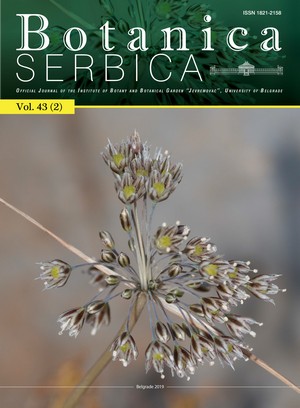
Volume 43 Issue 2 2019 |
Editorial
|
Physiological responses of Xanthoria parietina to longterm copper excess: role of the extracellular secondary metabolite parietin
|
KEY WORDS: parietin, lichens, heavy metals, accumulation, tolerance |
Biogeographic traits of the bryophyte flora of Serbia
|
KEY WORDS: distributional element, range types, mosses, liverworts |
Morphoanatomical study of Matricaria L. (Asteraceae) in Turkey
|
KEY WORDS: Matricaria, morphometry, achene anatomy, Turkey, taxonomy |
Humic acid protects against oxidative damage induced by cadmium toxicity in wheat (Triticum aestivum) roots through water management and the antioxidant defence system
|
KEY WORDS: Ascorbate-glutathione cycle, humic acid, lipid peroxidation, oxidative stress, Triticum aestivum |
Congeneric comparison of allelopathic and autotoxic effects of four Solidago species
|
KEY WORDS: allelopathy, germination, inhibition, invasive plants, Solidago |
Fresh fruits and jam of Sorbus domestica L. and Sorbus intermedia (Ehrh.) Pers.: phenolic profiles, antioxidant action and antimicrobial activity
|
KEY WORDS: Sorbus, phenolics, Ascorbic acid, antioxidant action, antimicrobial activity |
Allium panormitisi (Amaryllidaceae), a new autumn-flowering species from Symi Island, SE Aegean, Greece
|
KEY WORDS: Codonoprasum, chromosome number, Dodecanisos, karyology, taxonomy, conservation |


